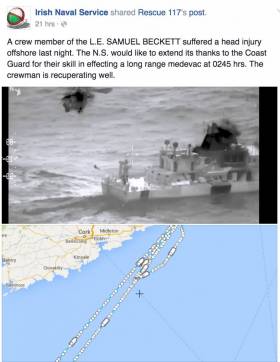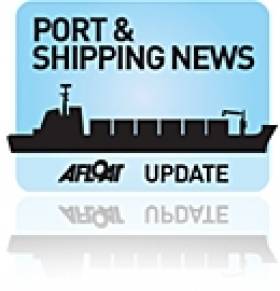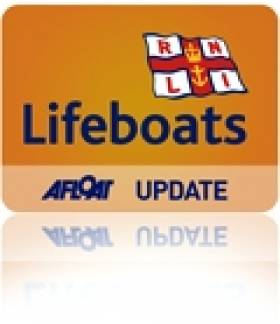Displaying items by tag: Irish Coastguard
#CrewInjury - The Naval Service has thanks to the Irish Coast Guard’s Shannon and Waterford helicopter crews for their assistance in an early morning (Tuesday) medevac from one of their vessels.
The Clare Herald writes that a crew member on board the L.E. Samuel Beckett was airlifted to hospital in the early hours after suffering an injury on board.
Irish Coast Guard search and rescue helicopters from Shannon and Waterford were involved in the operation.
The Naval Service has confirmed that a crew member on board the Samuel Beckett suffered a head injury in an ‘offshore’ incident. The accident happened at around 1.00am about 120 kilometres south of Cork.
To read more of the newspaper's coverage click here.
Container Ship Successfully Refloated in Waterford Harbour
In attendance was Bargarth, a UK-flagged tug based in Waterford and operated by Fastnet Shipping. The twin Voith & fire-fighting tug made a special appearance during the Tall Ships Races Parade of Sail on 3 July, when she put on a celebratory water-display off Dunmore East.
Samskip Eandeavour is capable of handling 812 twenty-foot equivalent containers (TEU). She was completed only this year by Damen Gorinchem Scheepswerf B.V. Foxtol in the Netherlands. The vessel is operated by an Icelandic company, Samskip which provides several container feeder-liner services between Rotterdam / Zeebrugge with Belfast, Dublin, Cork and Waterford.
After unloading and loading at Belview the 140m vessel is scheduled to dock in the Port of Cork tomorrow at the Tivoli Container Terminal before returning to Europe.
Ferry Runs Aground off Doolin for Three Hours
According to ferry operator Kevin O'Brien, there were no passengers on board at the time and the vessel got under way again when it was lifted from the rocks with the tide. Mr O'Brien added "this was a very minor incident and there was no damage to the ferry. Doolin is tidal so these things do happen. Even a few inches of water can make a difference".
The Irish Coast Guard was notified of the incident at midday, and its marine rescue co-ordination centre in Dublin requested that members of the local Coast Guard unit board the vessel to assess if there was a pollution risk.
Doolin Coast Guard personnel carried out an inspection and confirmed the ferry had not been damaged and there was no risk of pollution. At about 2.15pm the ferry got under way again with the tide. The company was able to operate services to and from the Aran Islands with its second vessel.
Galway Lifeboat Rescues Person Stranded near Hare Island
A member of the public rang the Irish Coastguard to report a person surrounded by water halfway across the causeway at approximately 3.10pm.
The Coastguard tasked Galway RNLI lifeboat, which launched within four minutes from Galway Docks. The lifeboat carried out a search of the area but did not find anyone in the water. The crew were informed a short time later that the person had made it safely ashore and did not require medical attention.
Galway's Lifeboat Operations Manager, Mike Swan, urges people to be careful when walking on or along the shore, as the tide can come in very fast:
"People may be aware of the tides but they are still getting caught out, particularly in Renmore at Ballyloughane Beach".
The volunteer lifeboat crew on this call-out were: Helmsman John Byrne, Martin Oliver and Keith Faller.
Related Safety posts
RNLI Lifeboats in Ireland
Safety News
Rescue News from RNLI Lifeboats in Ireland
Coast Guard News from Ireland
Water Safety News from Ireland
Marine Casualty Investigation Board News
Marine Warnings



























































